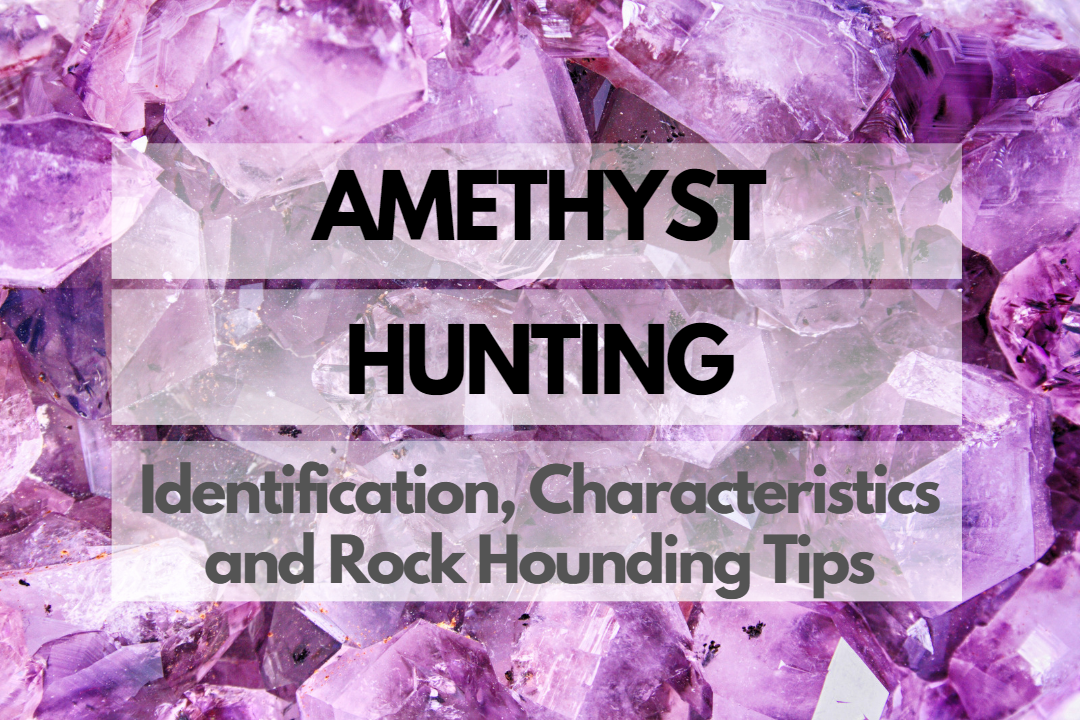Amethyst, a stunning and sought-after gemstone, is a popular item for rock hounds and mineral enthusiasts alike. This beautiful purple variety of quartz has captured the hearts and imaginations of collectors for centuries, and hunting for Amethyst can be an exciting and rewarding adventure. In this article, we will delve into the history, identification, characteristics, and uses of Amethyst, along with tips on how to find and value this captivating gemstone.
History & Origin of Amethyst
Amethyst has a rich history dating back to ancient civilizations. The name “Amethyst” is derived from the Greek word “amethystos,” which means “not intoxicated.” The ancient Greeks believed that Amethyst could protect them from drunkenness and would often wear it or use it in drinking vessels. This gemstone has also been associated with various cultural and religious significances, including being used by the Egyptians in protective amulets and by the Catholic Church in bishops’ rings.
Amethyst Identification & Physical Properties
Identifying Amethyst involves examining its physical properties, such as color, hardness, and crystal habit. The table below provides an overview of these properties:
| Property | Description |
|---|---|
| Color | Shades of purple, from pale lilac to deep violet |
| Hardness | 7 on the Mohs scale |
| Crystal Habit | Hexagonal prismatic crystals, often terminated by pyramidal faces |
| Transparency | Transparent to translucent |
| Luster | Vitreous |
| Cleavage | None |
| Fracture | Conchoidal |
Amethyst Colors
Amethyst is renowned for its beautiful purple color, which can vary from pale lilac to deep violet. The color intensity is often determined by the amount of iron impurities present in the crystal structure. Amethyst with a deeper color is typically more valuable, with the most desirable hue being a rich, deep purple with flashes of red or blue.
Amethyst Hardness
Amethyst has a hardness of 7 on the Mohs scale, which makes it a relatively durable gemstone suitable for use in jewelry and other applications. However, care should still be taken to avoid scratching or damaging the stone, as it is not as hard as other popular gemstones like diamonds or sapphires.
Amethyst Types
There are several types of Amethyst that vary in color, crystal habit, and geological formation. Some of the most notable types include:
Brandberg Amethyst
Found in the Brandberg Mountains of Namibia, this variety of Amethyst is known for its stunning color zoning, which features a combination of purple Amethyst, clear quartz, and smoky quartz. Brandberg Amethyst is highly sought after for its powerful metaphysical properties and unique beauty.
Veracruz Amethyst
Originating from the Veracruz region of Mexico, Veracruz Amethyst is characterized by its pale lilac color and slender, elongated prismatic crystals. This type of Amethyst is particularly prized for its delicate color and unique crystal formations.
Canadian Amethyst
Found in the Thunder Bay area of Ontario, Canada, this variety of Amethyst is known for its vibrant purple color, often with red or orange hematite inclusions. The presence of these inclusions can create an attractive and distinctive appearance, making Canadian Amethyst a popular choice among collectors.
Amethyst Uses
- Jewelry: Amethyst is commonly used in various types of jewelry, including rings, necklaces, bracelets, and earrings.
- Decorative items: Amethyst geodes, clusters, and carved pieces are often used for home décor and as collectible specimens.
- Metaphysical practices: Many people believe that Amethyst has calming and balancing properties, makingit a popular choice for meditation, energy work, and crystal healing.
- Art: Amethyst has been used as a pigment in paints and as a material in sculptures and other works of art.
How Much Is Amethyst Worth?
The value of Amethyst can vary greatly depending on factors such as color, clarity, size, and cut. In general, Amethyst with a deeper purple color and fewer inclusions will be more valuable. Prices can range from just a few dollars per carat for lower quality stones to several hundred dollars per carat for high-quality specimens. Additionally, rare types of Amethyst or stones with unique inclusions or crystal formations may command a premium price.
Amethyst Rock Hounding Tips
Hunting for Amethyst can be an exciting and rewarding experience. With a little bit of know-how and the right tools, you can increase your chances of finding this beautiful gemstone. Here are some tips and tricks to help you have a successful hunt:
Essential Tools and Equipment
Having the right tools can make your Amethyst hunting experience more enjoyable and productive. Some essential tools and equipment to consider include:
- Rock hammer: A sturdy hammer for breaking open rocks and revealing hidden treasures.
- Chisel: A chisel can help you extract Amethyst crystals from host rock without damaging them.
- Hand lens or loupe: A magnifying lens will allow you to examine your finds more closely and identify Amethyst more easily.
- Hard hat and safety glasses: Safety gear is crucial to protect yourself from flying rock chips and debris while hammering and chiseling.
- Backpack or collecting bag: A durable bag will help you carry your tools and collected specimens with ease.
- Gloves: Sturdy gloves can protect your hands from sharp edges and rough surfaces.
Safety Tips
Rock hounding can be a fun and safe activity if you follow some basic safety guidelines:
- Always wear appropriate safety gear, including a hard hat, safety glasses, and sturdy gloves.
- Never hammer or chisel directly towards your face or body. Always work at an angle away from yourself.
- Be aware of your surroundings and watch for potential hazards such as loose rocks, steep slopes, and wildlife.
- Stay hydrated and take breaks when needed, especially in hot or remote locations.
- Bring a buddy or let someone know your plans, so they can check on you or know where to look if you need help.
Amethyst Hunting: Where to Find Amethyst
Amethyst can be found in various locations around the world, with some of the best sources being Brazil, Uruguay, Madagascar, and Russia. Here’s a table detailing some specific sites and areas where you can find Amethyst:
| Site/Area | Location |
|---|---|
| Marabá Amethyst Mine | Marabá, Pará, Brazil |
| Artigas Amethyst Mines | Artigas, Uruguay |
| Anahi Mine | Amambay, Paraguay |
| Thunder Bay Amethyst Mines | Thunder Bay, Ontario, Canada |
| Mursinka Mines | Ural Mountains, Russia |
| Four Peaks Amethyst Mine | Mazatzal Mountains, Arizona, USA |
Caring For Your Amethyst
Once you’ve found your Amethyst treasures, it’s essential to care for them properly. Here are some tips for keeping your Amethyst in pristine condition:
- Avoid exposing your Amethyst to direct sunlight for extended periods, as this can cause the color to fade over time.
- Clean your Amethyst using warm water, mild soap, and a soft brush. Avoid using harsh chemicals or abrasives that could scratch the surface.
- Store your Amethyst separately from harder gemstones to prevent scratches and damage.
Additional Resources
Here are some helpful resources to deepen your knowledge and understanding of Amethyst and rock hounding in general:
- Mindat.org: A comprehensive online mineralogical database with information on thousands of minerals, including Amethyst.
- American Federation of Mineralogical Societies: A network of mineral clubs and societies in the United States, providing resources and support for rock hounds.
- USGS: A Collector’s Guide to Rock, Mineral, and Fossil Localities: A guide from the United States Geological Survey with information on collecting sites across the country.
- Rock & Gem Magazine: A monthly publication covering various aspects of rock hounding, including articles on Amethyst and other gemstones.
Additional Amethyst FAQs
What are the benefits of Amethyst?
Amethyst is a beautiful and versatile gemstone, prized for its stunning violet color and unique crystal formations. It has been used in jewelry and decorative objects for centuries and is considered a valuable addition to any rock or mineral collection.
Do Amethyst have any healing properties?
While there is no scientific evidence to support the idea of healing properties in gemstones, many people believe that Amethyst can help with a variety of issues, including stress relief, promoting mental clarity, and improving sleep quality. It’s up to individual beliefs and experiences to determine the potential benefits of Amethyst in this regard.
Do Amethyst have any spiritual meaning?
In various spiritual practices and belief systems, Amethyst is often associated with spiritual growth, protection, and the opening of the third eye or intuition. It is also connected to the crown chakra, which is believed to be the center of spiritual wisdom and enlightenment.
Do I need a permit to go Amethyst hunting?
Whether or not you need a permit for Amethyst hunting depends on the location and specific regulations in place. In some areas, you may need a permit or permission from the landowner to collect specimens. It’s essential to research the rules in your selected hunting area and follow them accordingly. For more information on permits in the United States, visit the Bureau of Land Management’s Rockhounding page.
Closing Thoughts
Amethyst hunting can be a thrilling and rewarding adventure for rock hounds of all ages and experience levels. By following our tips and guidelines, you’ll be well-prepared to embark on your own Amethyst hunting journey. Remember to stay safe, respect the environment, and enjoy the process of discovering these beautiful violet gems. Happy rock hounding!

